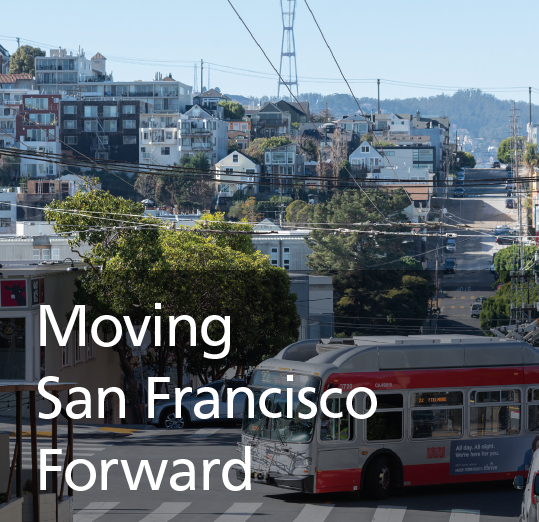By Madhu Unnikrishnan

The Covid-19 pandemic changed the way transit systems – and cities – across the country function, but with the worst of the pandemic now behind us, the SFMTA is focused on the future. In our latest annual report, we announced that Muni ridership had recovered to 63% of pre-pandemic levels, but our ridership has continued to recover, ending 2023 at 71% of its pre-pandemic level.
The reason for the discrepancy? Our annual report, Moving San Francisco Forward, reflects the fiscal year, which ends on June 30. So, our most recent annual report covers the period from July 1, 2022-June 30, 2023. In the six months since the data for the SFMTA annual report was collected, ridership has continued to recover.
Where we have made transit priority investments, the numbers are even better. Ridership on the new Van Ness Bus Rapid Transit corridor is exceeding pre-pandemic levels, at 131% of 2019 ridership. Similarly, the 22 Fillmore is at 138% of its 2019 ridership on weekends, and the 14R on Mission has seen ridership reach 117% of its 2019 weekend levels. That’s in addition to the 2,700 weekday boardings reported at the four new stations on the T Third line in the Central Subway, which opened last year. Look out for more details in an upcoming blog diving deeper into 2023 Muni ridership.
Beyond ridership numbers, we saw significant improvements in street safety. In case you aren’t familiar with it, Vision Zero is San Francisco’s policy to eliminate traffic fatalities. Seniors and people walking and using scooters make up the highest percentage of traffic deaths on our streets. It is a moral goal that no one should die on the streets of San Francisco. In 2014, San Francisco and New York were the first U.S. cities to adopt Vision Zero principles and set a goal of zero. Since then, about 50 other cities in the United States, as well as the state of California and the federal government, have also set zero deaths as their transportation safety goals.
While there were 39 traffic fatalities in 2022, that number fell to 26 in 2023, a 33% decrease. Bicycle-related fatalities have also decreased — they have gone down by 50% in the last four years. Even one fatality on our streets is too many, so we’re focused on bringing those numbers down further, and we are seeing signs of improvement.
One of the primary areas of focus for Vision Zero is to reduce speeding, as speed can increase the severity of crashes, particularly for vulnerable road users like pedestrians. We’re taking many steps to reduce speed, including installing what we call “traffic-calming devices” such as speed humps, raised crosswalks, median islands and traffic circles, among other measures. By the end of last year, we had installed about 250 traffic-calming devices. We have also installed Quick-Build pedestrian and bicycle safety improvements on 32 corridors since 2019, resulting in 50 miles of traffic safety improvements for San Franciscans who choose to walk or bike. We’re currently in the planning phase for several more corridors this year.
Another way we’re making the streets of our city safer is by reducing the speed limit to 20 miles per hour on select streets. The data shows that slowing vehicle speeds is one of the most effective tools we have to prevent traffic deaths. By the end of last year, the SFMTA had reduced the speed limit to 20 miles per hour on 43 miles of city streets, up from 25.5 street miles at the end of June 2023.
We’re also working to educate some of our most underserved communities on the services we provide. Last year, we opened a new Transportation Resource Center in the Bayview, historically one of San Francisco’s most under-resourced neighborhoods. Staff at the center help people sign up for Clipper cards and Muni Transit Passes, access paratransit services, learn how to use the MuniMobile app and find out how to access micromobility programs, like Scootershare and Bikeshare services. To better serve the Bayview-Hunter’s Point neighborhood, the SFMTA plans to launch a new Bayview Community Shuttle later this year.
The SFMTA has been hard at work on improving the transit system, roads and bikeways we all depend on. Here are some of the statistics from the end of calendar year 2023:
-
Provided more than 500,000 paratransit trips.
-
Made more than 3,900 repairs to transit shelter glass and seats.
-
Increased transit stop cleaning by 50% compared with previous years.
-
Offered 467 miles of bikeways, with 45 miles of protected bikeways (compared with 43 miles at the end of the fiscal year).
You can learn more about these accomplishments and others in our annual report (SFMTA.com/AnnualReport).
We’d like to thank our employees for the tremendous amount of work and dedication it took to achieve these milestones and to help us continue on this upward trajectory. And, we’d like to hear from you! Some of these projects – bikeways and increased service on heavily traveled bus lines, among others – stemmed from what we heard from our city. Please comment below or email us at InsideSFMTA@SFMTA.com.
Published January 25, 2024 at 06:04AM
https://ift.tt/YS2dVm5
Comments
Post a Comment